Law and Medicine: Law Reform Proposal on No-Fault Compensation Scheme
VerifiedAdded on 2022/09/11
|16
|4383
|36
Report
AI Summary
This law reform submission critically examines the proposal to enact legislation establishing a no-fault compensation scheme for medical injuries, replacing the current fault-based tort litigation system. The report begins with an abstract summarizing the key arguments, followed by a background section that contextualizes the issue's contemporary relevance to lawmakers, the medical profession, and the public. The author states a strong opposition to the proposal, citing concerns about potential recklessness within the medical industry due to a lack of consequences, and the effectiveness of the current system in ensuring accountability. The core of the submission is a detailed discussion supporting this position, drawing on legal precedents like Bolam v Friern Hospital Management Committee and Donoghue v Stevenson, as well as research sources, to argue that the current system's emphasis on negligence deters recklessness, ensures a standard of care, and provides a means for compensation. The author contends that a no-fault system would expose the public to greater risks and potentially diminish professional standards in medicine. The submission highlights the importance of maintaining legal accountability to uphold ethical standards and protect patient rights.
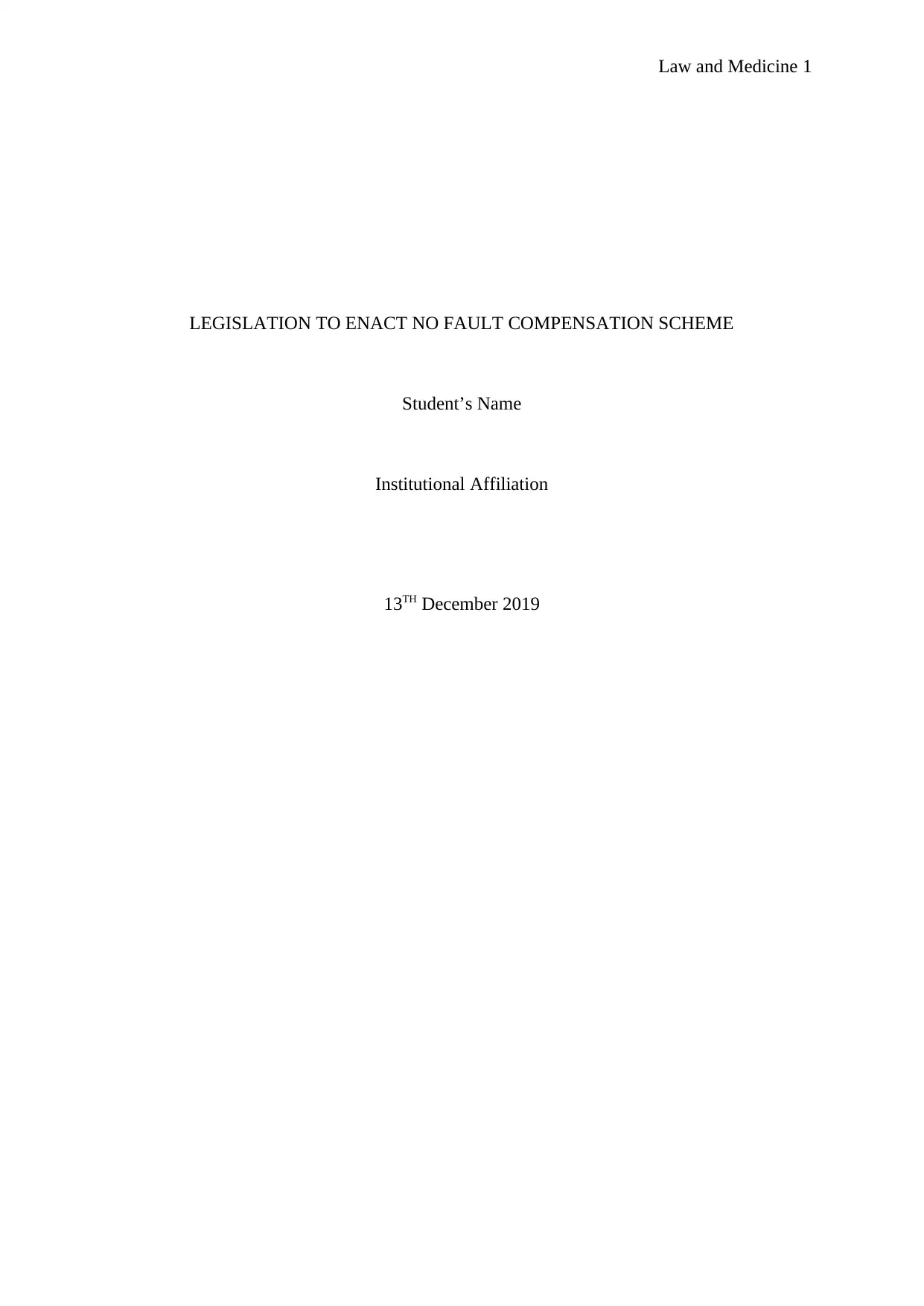
Law and Medicine 1
LEGISLATION TO ENACT NO FAULT COMPENSATION SCHEME
Student’s Name
Institutional Affiliation
13TH December 2019
LEGISLATION TO ENACT NO FAULT COMPENSATION SCHEME
Student’s Name
Institutional Affiliation
13TH December 2019
Paraphrase This Document
Need a fresh take? Get an instant paraphrase of this document with our AI Paraphraser
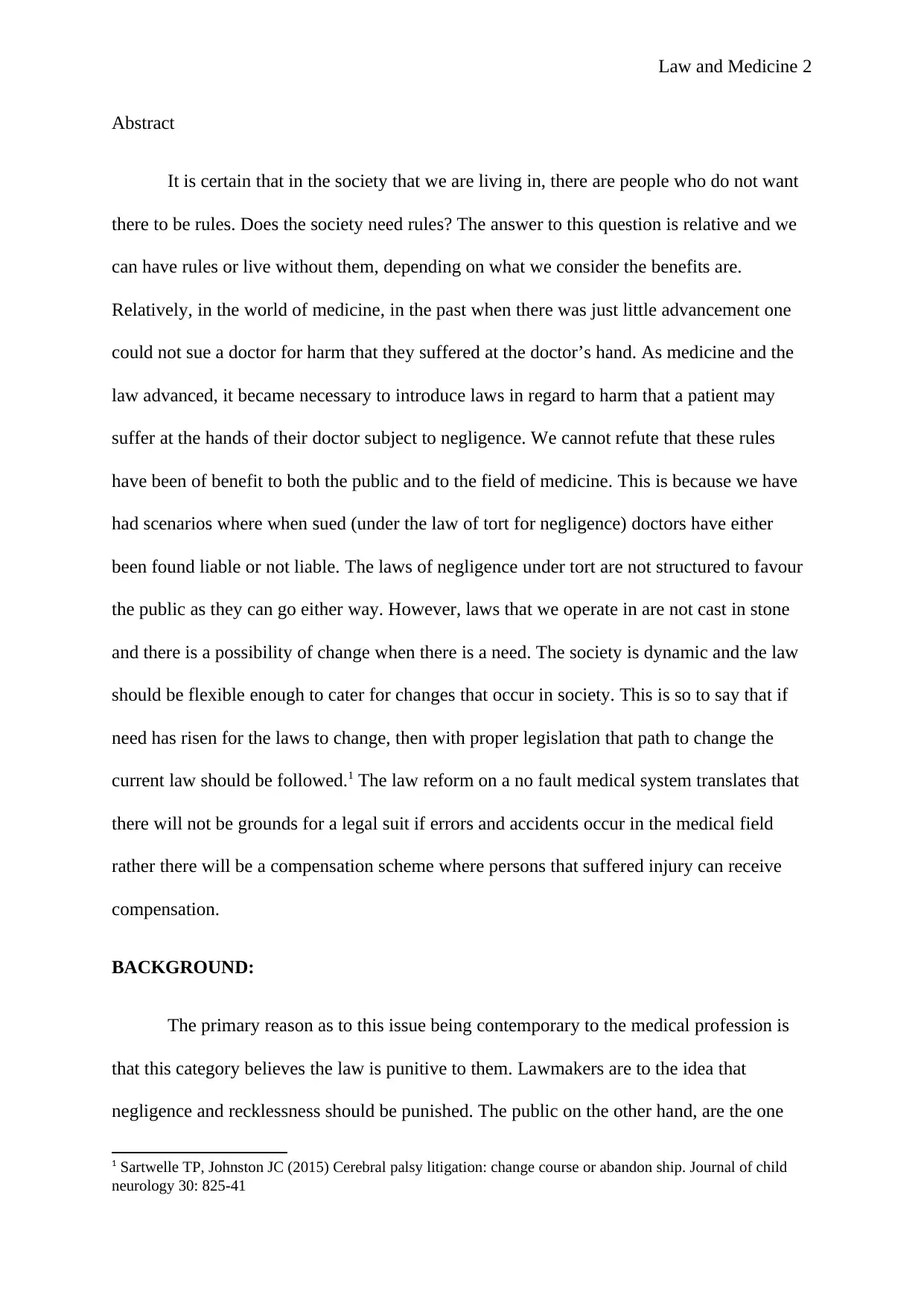
Law and Medicine 2
Abstract
It is certain that in the society that we are living in, there are people who do not want
there to be rules. Does the society need rules? The answer to this question is relative and we
can have rules or live without them, depending on what we consider the benefits are.
Relatively, in the world of medicine, in the past when there was just little advancement one
could not sue a doctor for harm that they suffered at the doctor’s hand. As medicine and the
law advanced, it became necessary to introduce laws in regard to harm that a patient may
suffer at the hands of their doctor subject to negligence. We cannot refute that these rules
have been of benefit to both the public and to the field of medicine. This is because we have
had scenarios where when sued (under the law of tort for negligence) doctors have either
been found liable or not liable. The laws of negligence under tort are not structured to favour
the public as they can go either way. However, laws that we operate in are not cast in stone
and there is a possibility of change when there is a need. The society is dynamic and the law
should be flexible enough to cater for changes that occur in society. This is so to say that if
need has risen for the laws to change, then with proper legislation that path to change the
current law should be followed.1 The law reform on a no fault medical system translates that
there will not be grounds for a legal suit if errors and accidents occur in the medical field
rather there will be a compensation scheme where persons that suffered injury can receive
compensation.
BACKGROUND:
The primary reason as to this issue being contemporary to the medical profession is
that this category believes the law is punitive to them. Lawmakers are to the idea that
negligence and recklessness should be punished. The public on the other hand, are the one
1 Sartwelle TP, Johnston JC (2015) Cerebral palsy litigation: change course or abandon ship. Journal of child
neurology 30: 825-41
Abstract
It is certain that in the society that we are living in, there are people who do not want
there to be rules. Does the society need rules? The answer to this question is relative and we
can have rules or live without them, depending on what we consider the benefits are.
Relatively, in the world of medicine, in the past when there was just little advancement one
could not sue a doctor for harm that they suffered at the doctor’s hand. As medicine and the
law advanced, it became necessary to introduce laws in regard to harm that a patient may
suffer at the hands of their doctor subject to negligence. We cannot refute that these rules
have been of benefit to both the public and to the field of medicine. This is because we have
had scenarios where when sued (under the law of tort for negligence) doctors have either
been found liable or not liable. The laws of negligence under tort are not structured to favour
the public as they can go either way. However, laws that we operate in are not cast in stone
and there is a possibility of change when there is a need. The society is dynamic and the law
should be flexible enough to cater for changes that occur in society. This is so to say that if
need has risen for the laws to change, then with proper legislation that path to change the
current law should be followed.1 The law reform on a no fault medical system translates that
there will not be grounds for a legal suit if errors and accidents occur in the medical field
rather there will be a compensation scheme where persons that suffered injury can receive
compensation.
BACKGROUND:
The primary reason as to this issue being contemporary to the medical profession is
that this category believes the law is punitive to them. Lawmakers are to the idea that
negligence and recklessness should be punished. The public on the other hand, are the one
1 Sartwelle TP, Johnston JC (2015) Cerebral palsy litigation: change course or abandon ship. Journal of child
neurology 30: 825-41
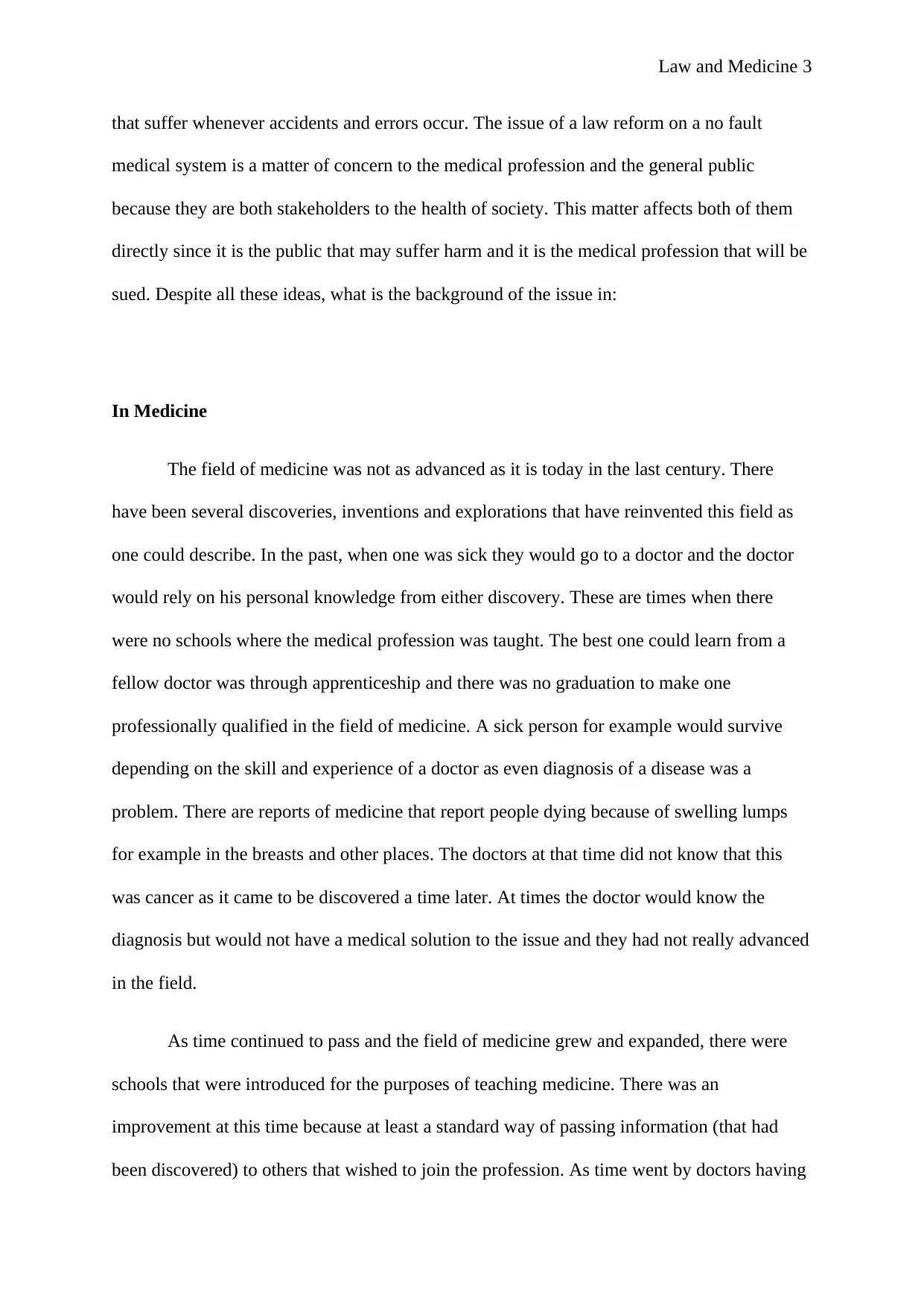
Law and Medicine 3
that suffer whenever accidents and errors occur. The issue of a law reform on a no fault
medical system is a matter of concern to the medical profession and the general public
because they are both stakeholders to the health of society. This matter affects both of them
directly since it is the public that may suffer harm and it is the medical profession that will be
sued. Despite all these ideas, what is the background of the issue in:
In Medicine
The field of medicine was not as advanced as it is today in the last century. There
have been several discoveries, inventions and explorations that have reinvented this field as
one could describe. In the past, when one was sick they would go to a doctor and the doctor
would rely on his personal knowledge from either discovery. These are times when there
were no schools where the medical profession was taught. The best one could learn from a
fellow doctor was through apprenticeship and there was no graduation to make one
professionally qualified in the field of medicine. A sick person for example would survive
depending on the skill and experience of a doctor as even diagnosis of a disease was a
problem. There are reports of medicine that report people dying because of swelling lumps
for example in the breasts and other places. The doctors at that time did not know that this
was cancer as it came to be discovered a time later. At times the doctor would know the
diagnosis but would not have a medical solution to the issue and they had not really advanced
in the field.
As time continued to pass and the field of medicine grew and expanded, there were
schools that were introduced for the purposes of teaching medicine. There was an
improvement at this time because at least a standard way of passing information (that had
been discovered) to others that wished to join the profession. As time went by doctors having
that suffer whenever accidents and errors occur. The issue of a law reform on a no fault
medical system is a matter of concern to the medical profession and the general public
because they are both stakeholders to the health of society. This matter affects both of them
directly since it is the public that may suffer harm and it is the medical profession that will be
sued. Despite all these ideas, what is the background of the issue in:
In Medicine
The field of medicine was not as advanced as it is today in the last century. There
have been several discoveries, inventions and explorations that have reinvented this field as
one could describe. In the past, when one was sick they would go to a doctor and the doctor
would rely on his personal knowledge from either discovery. These are times when there
were no schools where the medical profession was taught. The best one could learn from a
fellow doctor was through apprenticeship and there was no graduation to make one
professionally qualified in the field of medicine. A sick person for example would survive
depending on the skill and experience of a doctor as even diagnosis of a disease was a
problem. There are reports of medicine that report people dying because of swelling lumps
for example in the breasts and other places. The doctors at that time did not know that this
was cancer as it came to be discovered a time later. At times the doctor would know the
diagnosis but would not have a medical solution to the issue and they had not really advanced
in the field.
As time continued to pass and the field of medicine grew and expanded, there were
schools that were introduced for the purposes of teaching medicine. There was an
improvement at this time because at least a standard way of passing information (that had
been discovered) to others that wished to join the profession. As time went by doctors having
⊘ This is a preview!⊘
Do you want full access?
Subscribe today to unlock all pages.

Trusted by 1+ million students worldwide

Law and Medicine 4
been trained were now expected to perform to specific levels and this is because the society
developed and so they had to. There are a lot of people in the past that died even having
passed through the hands of a trained doctor. This was a normal scene as not everyone that
was treated was expected to recover from the ailment. Real trouble arose when it was
discovered that doctors could sometimes avoid harm and accidents if they could have been a
little bit careful. Some cases where harm had occurred, it was found that the doctor had been
negligent in conducting their activities and so could have been avoided if they were more
careful this lead to the introduction of one being liable for negligence that led to a patient
suffering harm. The argument here is that since there is professionalism that is currently
available, it should be practiced to the highest levels.
In Law
Law on the other side, as discussed earlier, developed hand in hand with the changes
that occurred in society. Sometimes the society changed faster demanding laws to be
introduced and sometimes the law developed faster demanding the society to abide by it. In
the past there were no laws regarding a doctor and patient because the first of all the patient
was at the mercy of the doctor. The doctor could refuse to treat the patient and this could lead
to no legal claim. The doctor could also say that he does not know the diagnosis as no
training had been done to them. It would of course be absurd to punish the doctor because of
something they were not aware of and at times would just be guessing. However as the
society developed and medical schools started to produce professionals, the law shifted in a
manner that required the professionals to act in a particular standard manner. The same
happened in the in the field of medicine where doctors could be held liable if found negligent.
Negligence in the law of tort developed so as to make doctors to be more careful
when handling patients. There was an issue of recklessness that arose in the field of medicine
been trained were now expected to perform to specific levels and this is because the society
developed and so they had to. There are a lot of people in the past that died even having
passed through the hands of a trained doctor. This was a normal scene as not everyone that
was treated was expected to recover from the ailment. Real trouble arose when it was
discovered that doctors could sometimes avoid harm and accidents if they could have been a
little bit careful. Some cases where harm had occurred, it was found that the doctor had been
negligent in conducting their activities and so could have been avoided if they were more
careful this lead to the introduction of one being liable for negligence that led to a patient
suffering harm. The argument here is that since there is professionalism that is currently
available, it should be practiced to the highest levels.
In Law
Law on the other side, as discussed earlier, developed hand in hand with the changes
that occurred in society. Sometimes the society changed faster demanding laws to be
introduced and sometimes the law developed faster demanding the society to abide by it. In
the past there were no laws regarding a doctor and patient because the first of all the patient
was at the mercy of the doctor. The doctor could refuse to treat the patient and this could lead
to no legal claim. The doctor could also say that he does not know the diagnosis as no
training had been done to them. It would of course be absurd to punish the doctor because of
something they were not aware of and at times would just be guessing. However as the
society developed and medical schools started to produce professionals, the law shifted in a
manner that required the professionals to act in a particular standard manner. The same
happened in the in the field of medicine where doctors could be held liable if found negligent.
Negligence in the law of tort developed so as to make doctors to be more careful
when handling patients. There was an issue of recklessness that arose in the field of medicine
Paraphrase This Document
Need a fresh take? Get an instant paraphrase of this document with our AI Paraphraser
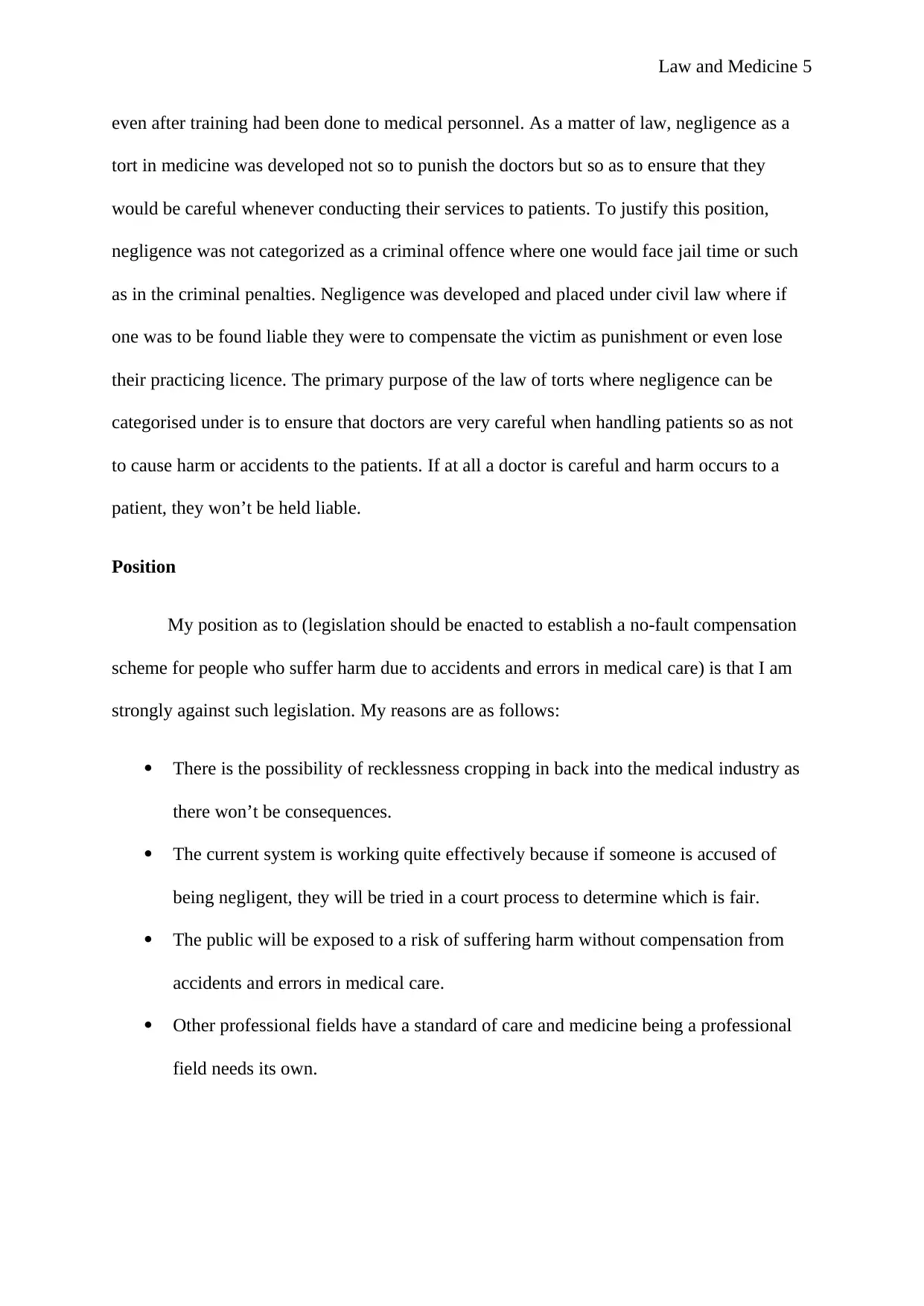
Law and Medicine 5
even after training had been done to medical personnel. As a matter of law, negligence as a
tort in medicine was developed not so to punish the doctors but so as to ensure that they
would be careful whenever conducting their services to patients. To justify this position,
negligence was not categorized as a criminal offence where one would face jail time or such
as in the criminal penalties. Negligence was developed and placed under civil law where if
one was to be found liable they were to compensate the victim as punishment or even lose
their practicing licence. The primary purpose of the law of torts where negligence can be
categorised under is to ensure that doctors are very careful when handling patients so as not
to cause harm or accidents to the patients. If at all a doctor is careful and harm occurs to a
patient, they won’t be held liable.
Position
My position as to (legislation should be enacted to establish a no-fault compensation
scheme for people who suffer harm due to accidents and errors in medical care) is that I am
strongly against such legislation. My reasons are as follows:
There is the possibility of recklessness cropping in back into the medical industry as
there won’t be consequences.
The current system is working quite effectively because if someone is accused of
being negligent, they will be tried in a court process to determine which is fair.
The public will be exposed to a risk of suffering harm without compensation from
accidents and errors in medical care.
Other professional fields have a standard of care and medicine being a professional
field needs its own.
even after training had been done to medical personnel. As a matter of law, negligence as a
tort in medicine was developed not so to punish the doctors but so as to ensure that they
would be careful whenever conducting their services to patients. To justify this position,
negligence was not categorized as a criminal offence where one would face jail time or such
as in the criminal penalties. Negligence was developed and placed under civil law where if
one was to be found liable they were to compensate the victim as punishment or even lose
their practicing licence. The primary purpose of the law of torts where negligence can be
categorised under is to ensure that doctors are very careful when handling patients so as not
to cause harm or accidents to the patients. If at all a doctor is careful and harm occurs to a
patient, they won’t be held liable.
Position
My position as to (legislation should be enacted to establish a no-fault compensation
scheme for people who suffer harm due to accidents and errors in medical care) is that I am
strongly against such legislation. My reasons are as follows:
There is the possibility of recklessness cropping in back into the medical industry as
there won’t be consequences.
The current system is working quite effectively because if someone is accused of
being negligent, they will be tried in a court process to determine which is fair.
The public will be exposed to a risk of suffering harm without compensation from
accidents and errors in medical care.
Other professional fields have a standard of care and medicine being a professional
field needs its own.

Law and Medicine 6
DISCUSSION
• There is the possibility of recklessness cropping in back into the medical industry
as there won’t be consequences. Wallis (2006) observes that after New Zealand introduced
the no fault medical system, patient complaints increased from 1206 to 1318 per year on
average. Does this reflect increase of negligence in the field? As decided in the case of Bolam
v Friern Hospital Management Committee,2 the court was to the rationale that;
‘In the ordinary case which does not involve any special skill . . . negligence . . . means a
failure to do some act which a reasonable man in the circumstances would do, or the doing of
some act which a reasonable man in the circumstances would not do. . . . But where you get a
situation which involves the use of some special skill or competence, then the test as to
whether there has been negligence or not is not the test of the man on the top of a Clapham
omnibus, because he has not got this skill.’3
Medical personnel are held liable so as to prevent them from being reckless or negligent for
that matter. If at all we were to return to a position back in time where doctors would not be
liable, their professionalism would really diminish.4 It would be like a having a society
without rules. Imagine a society where anyone can do anything as so they wish and no
consequence would come to them; a society where everything is permissible to be done by
anyone. That is the position that we would be exposing the medical field to. Just like in
society where we live by the law and are aware of the consequences if we go against it, this
position of law in society has prevented a lot of people from committing crimes. And yes, one
would say that there are still crimes, but, the truth is the level of crime society deals with in
the existence of the law is way less. Having the law (tort of negligence) in place has not
2 [1957] 1 WLR 582 at 582
3 [1957] 1 WLR 582 at 582:
4 Hood L, Fenwick J, Butt J (2010) A story of scrutiny and fear: Australian midwives’ experiences of an
external review of obstetric services, being involved with litigation and the impact on clinical practice.
Midwifery, 26: 268-285
DISCUSSION
• There is the possibility of recklessness cropping in back into the medical industry
as there won’t be consequences. Wallis (2006) observes that after New Zealand introduced
the no fault medical system, patient complaints increased from 1206 to 1318 per year on
average. Does this reflect increase of negligence in the field? As decided in the case of Bolam
v Friern Hospital Management Committee,2 the court was to the rationale that;
‘In the ordinary case which does not involve any special skill . . . negligence . . . means a
failure to do some act which a reasonable man in the circumstances would do, or the doing of
some act which a reasonable man in the circumstances would not do. . . . But where you get a
situation which involves the use of some special skill or competence, then the test as to
whether there has been negligence or not is not the test of the man on the top of a Clapham
omnibus, because he has not got this skill.’3
Medical personnel are held liable so as to prevent them from being reckless or negligent for
that matter. If at all we were to return to a position back in time where doctors would not be
liable, their professionalism would really diminish.4 It would be like a having a society
without rules. Imagine a society where anyone can do anything as so they wish and no
consequence would come to them; a society where everything is permissible to be done by
anyone. That is the position that we would be exposing the medical field to. Just like in
society where we live by the law and are aware of the consequences if we go against it, this
position of law in society has prevented a lot of people from committing crimes. And yes, one
would say that there are still crimes, but, the truth is the level of crime society deals with in
the existence of the law is way less. Having the law (tort of negligence) in place has not
2 [1957] 1 WLR 582 at 582
3 [1957] 1 WLR 582 at 582:
4 Hood L, Fenwick J, Butt J (2010) A story of scrutiny and fear: Australian midwives’ experiences of an
external review of obstetric services, being involved with litigation and the impact on clinical practice.
Midwifery, 26: 268-285
⊘ This is a preview!⊘
Do you want full access?
Subscribe today to unlock all pages.

Trusted by 1+ million students worldwide
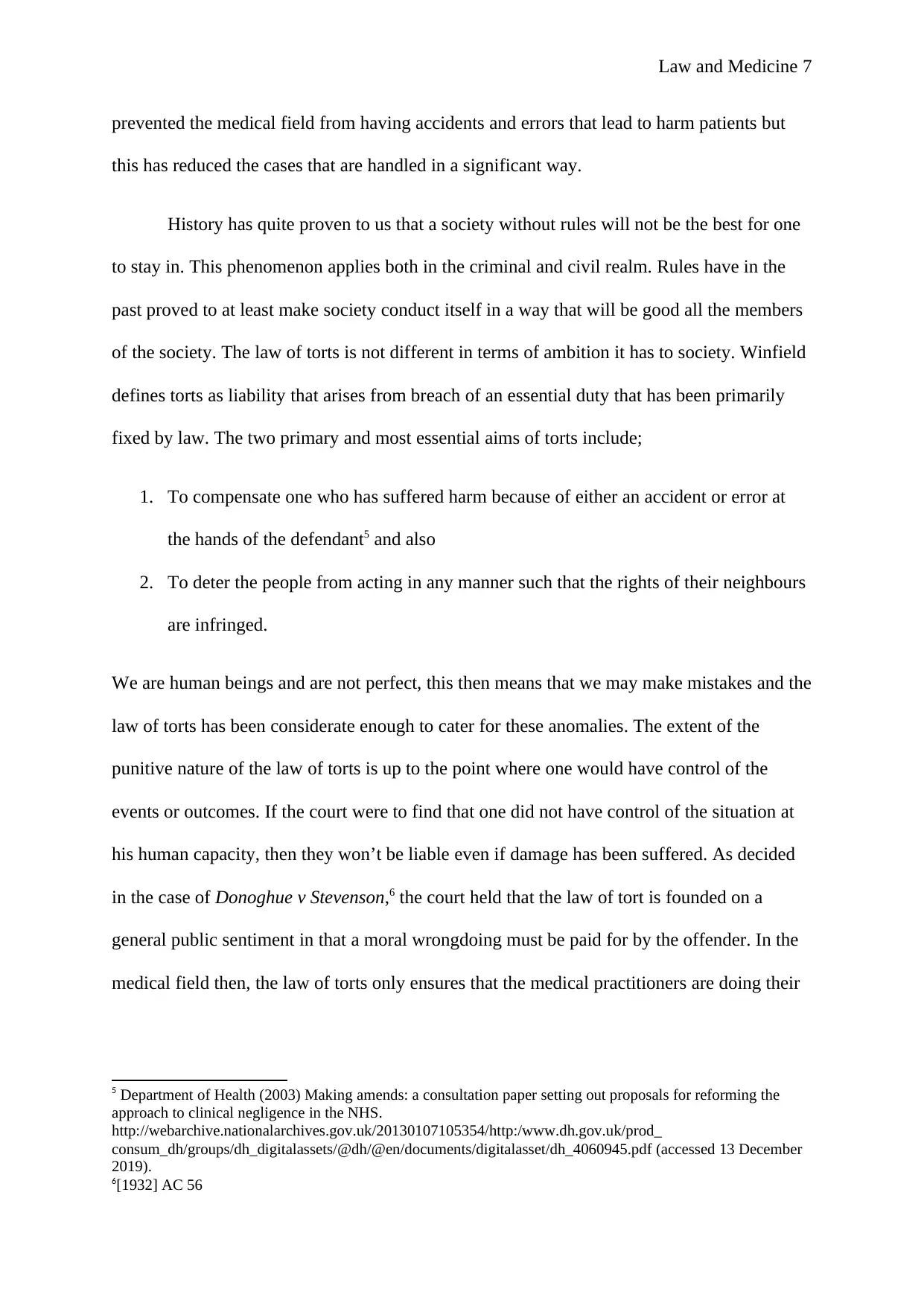
Law and Medicine 7
prevented the medical field from having accidents and errors that lead to harm patients but
this has reduced the cases that are handled in a significant way.
History has quite proven to us that a society without rules will not be the best for one
to stay in. This phenomenon applies both in the criminal and civil realm. Rules have in the
past proved to at least make society conduct itself in a way that will be good all the members
of the society. The law of torts is not different in terms of ambition it has to society. Winfield
defines torts as liability that arises from breach of an essential duty that has been primarily
fixed by law. The two primary and most essential aims of torts include;
1. To compensate one who has suffered harm because of either an accident or error at
the hands of the defendant5 and also
2. To deter the people from acting in any manner such that the rights of their neighbours
are infringed.
We are human beings and are not perfect, this then means that we may make mistakes and the
law of torts has been considerate enough to cater for these anomalies. The extent of the
punitive nature of the law of torts is up to the point where one would have control of the
events or outcomes. If the court were to find that one did not have control of the situation at
his human capacity, then they won’t be liable even if damage has been suffered. As decided
in the case of Donoghue v Stevenson,6 the court held that the law of tort is founded on a
general public sentiment in that a moral wrongdoing must be paid for by the offender. In the
medical field then, the law of torts only ensures that the medical practitioners are doing their
5 Department of Health (2003) Making amends: a consultation paper setting out proposals for reforming the
approach to clinical negligence in the NHS.
http://webarchive.nationalarchives.gov.uk/20130107105354/http:/www.dh.gov.uk/prod_
consum_dh/groups/dh_digitalassets/@dh/@en/documents/digitalasset/dh_4060945.pdf (accessed 13 December
2019).
6[1932] AC 56
prevented the medical field from having accidents and errors that lead to harm patients but
this has reduced the cases that are handled in a significant way.
History has quite proven to us that a society without rules will not be the best for one
to stay in. This phenomenon applies both in the criminal and civil realm. Rules have in the
past proved to at least make society conduct itself in a way that will be good all the members
of the society. The law of torts is not different in terms of ambition it has to society. Winfield
defines torts as liability that arises from breach of an essential duty that has been primarily
fixed by law. The two primary and most essential aims of torts include;
1. To compensate one who has suffered harm because of either an accident or error at
the hands of the defendant5 and also
2. To deter the people from acting in any manner such that the rights of their neighbours
are infringed.
We are human beings and are not perfect, this then means that we may make mistakes and the
law of torts has been considerate enough to cater for these anomalies. The extent of the
punitive nature of the law of torts is up to the point where one would have control of the
events or outcomes. If the court were to find that one did not have control of the situation at
his human capacity, then they won’t be liable even if damage has been suffered. As decided
in the case of Donoghue v Stevenson,6 the court held that the law of tort is founded on a
general public sentiment in that a moral wrongdoing must be paid for by the offender. In the
medical field then, the law of torts only ensures that the medical practitioners are doing their
5 Department of Health (2003) Making amends: a consultation paper setting out proposals for reforming the
approach to clinical negligence in the NHS.
http://webarchive.nationalarchives.gov.uk/20130107105354/http:/www.dh.gov.uk/prod_
consum_dh/groups/dh_digitalassets/@dh/@en/documents/digitalasset/dh_4060945.pdf (accessed 13 December
2019).
6[1932] AC 56
Paraphrase This Document
Need a fresh take? Get an instant paraphrase of this document with our AI Paraphraser
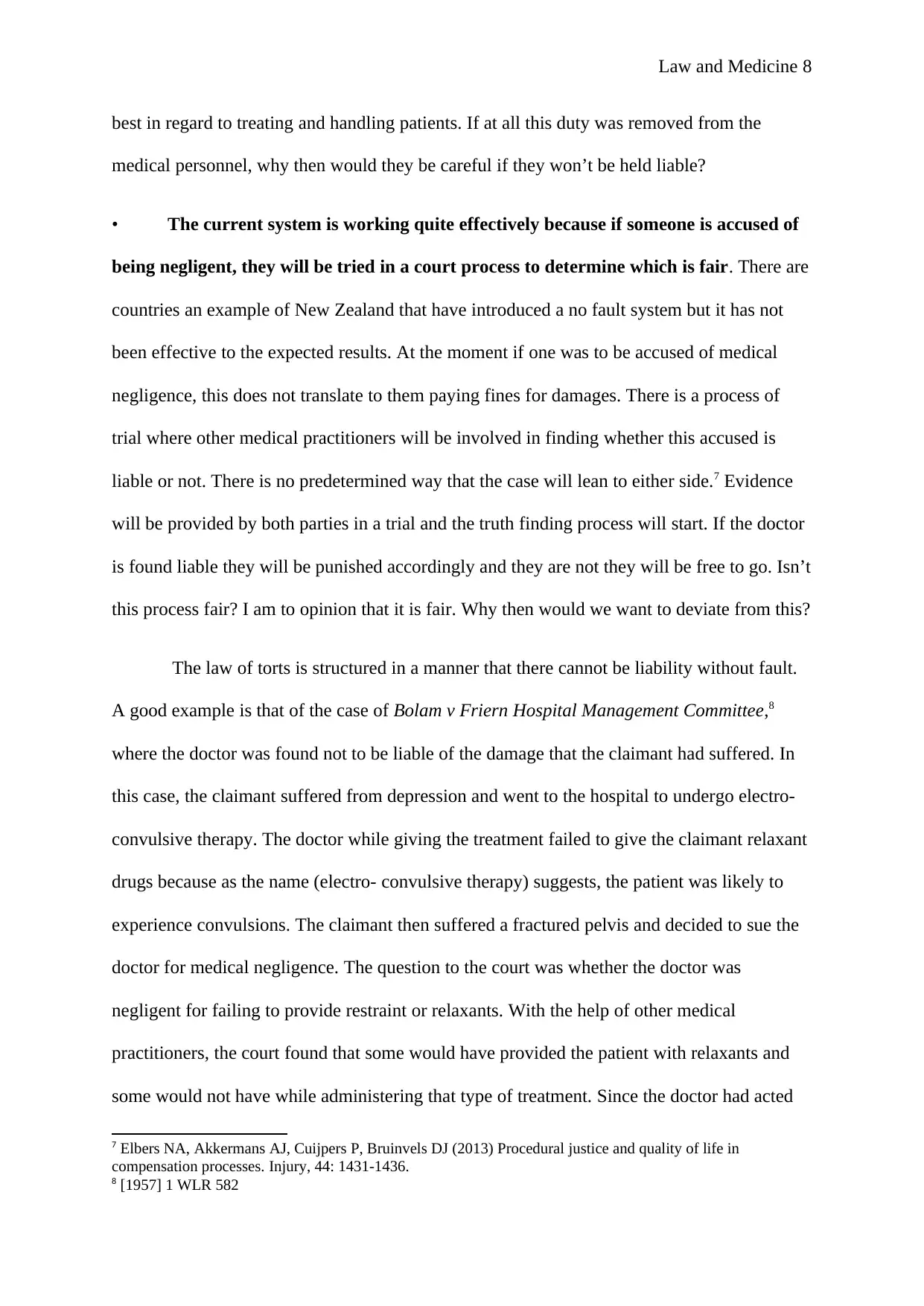
Law and Medicine 8
best in regard to treating and handling patients. If at all this duty was removed from the
medical personnel, why then would they be careful if they won’t be held liable?
• The current system is working quite effectively because if someone is accused of
being negligent, they will be tried in a court process to determine which is fair. There are
countries an example of New Zealand that have introduced a no fault system but it has not
been effective to the expected results. At the moment if one was to be accused of medical
negligence, this does not translate to them paying fines for damages. There is a process of
trial where other medical practitioners will be involved in finding whether this accused is
liable or not. There is no predetermined way that the case will lean to either side.7 Evidence
will be provided by both parties in a trial and the truth finding process will start. If the doctor
is found liable they will be punished accordingly and they are not they will be free to go. Isn’t
this process fair? I am to opinion that it is fair. Why then would we want to deviate from this?
The law of torts is structured in a manner that there cannot be liability without fault.
A good example is that of the case of Bolam v Friern Hospital Management Committee,8
where the doctor was found not to be liable of the damage that the claimant had suffered. In
this case, the claimant suffered from depression and went to the hospital to undergo electro-
convulsive therapy. The doctor while giving the treatment failed to give the claimant relaxant
drugs because as the name (electro- convulsive therapy) suggests, the patient was likely to
experience convulsions. The claimant then suffered a fractured pelvis and decided to sue the
doctor for medical negligence. The question to the court was whether the doctor was
negligent for failing to provide restraint or relaxants. With the help of other medical
practitioners, the court found that some would have provided the patient with relaxants and
some would not have while administering that type of treatment. Since the doctor had acted
7 Elbers NA, Akkermans AJ, Cuijpers P, Bruinvels DJ (2013) Procedural justice and quality of life in
compensation processes. Injury, 44: 1431-1436.
8 [1957] 1 WLR 582
best in regard to treating and handling patients. If at all this duty was removed from the
medical personnel, why then would they be careful if they won’t be held liable?
• The current system is working quite effectively because if someone is accused of
being negligent, they will be tried in a court process to determine which is fair. There are
countries an example of New Zealand that have introduced a no fault system but it has not
been effective to the expected results. At the moment if one was to be accused of medical
negligence, this does not translate to them paying fines for damages. There is a process of
trial where other medical practitioners will be involved in finding whether this accused is
liable or not. There is no predetermined way that the case will lean to either side.7 Evidence
will be provided by both parties in a trial and the truth finding process will start. If the doctor
is found liable they will be punished accordingly and they are not they will be free to go. Isn’t
this process fair? I am to opinion that it is fair. Why then would we want to deviate from this?
The law of torts is structured in a manner that there cannot be liability without fault.
A good example is that of the case of Bolam v Friern Hospital Management Committee,8
where the doctor was found not to be liable of the damage that the claimant had suffered. In
this case, the claimant suffered from depression and went to the hospital to undergo electro-
convulsive therapy. The doctor while giving the treatment failed to give the claimant relaxant
drugs because as the name (electro- convulsive therapy) suggests, the patient was likely to
experience convulsions. The claimant then suffered a fractured pelvis and decided to sue the
doctor for medical negligence. The question to the court was whether the doctor was
negligent for failing to provide restraint or relaxants. With the help of other medical
practitioners, the court found that some would have provided the patient with relaxants and
some would not have while administering that type of treatment. Since the doctor had acted
7 Elbers NA, Akkermans AJ, Cuijpers P, Bruinvels DJ (2013) Procedural justice and quality of life in
compensation processes. Injury, 44: 1431-1436.
8 [1957] 1 WLR 582
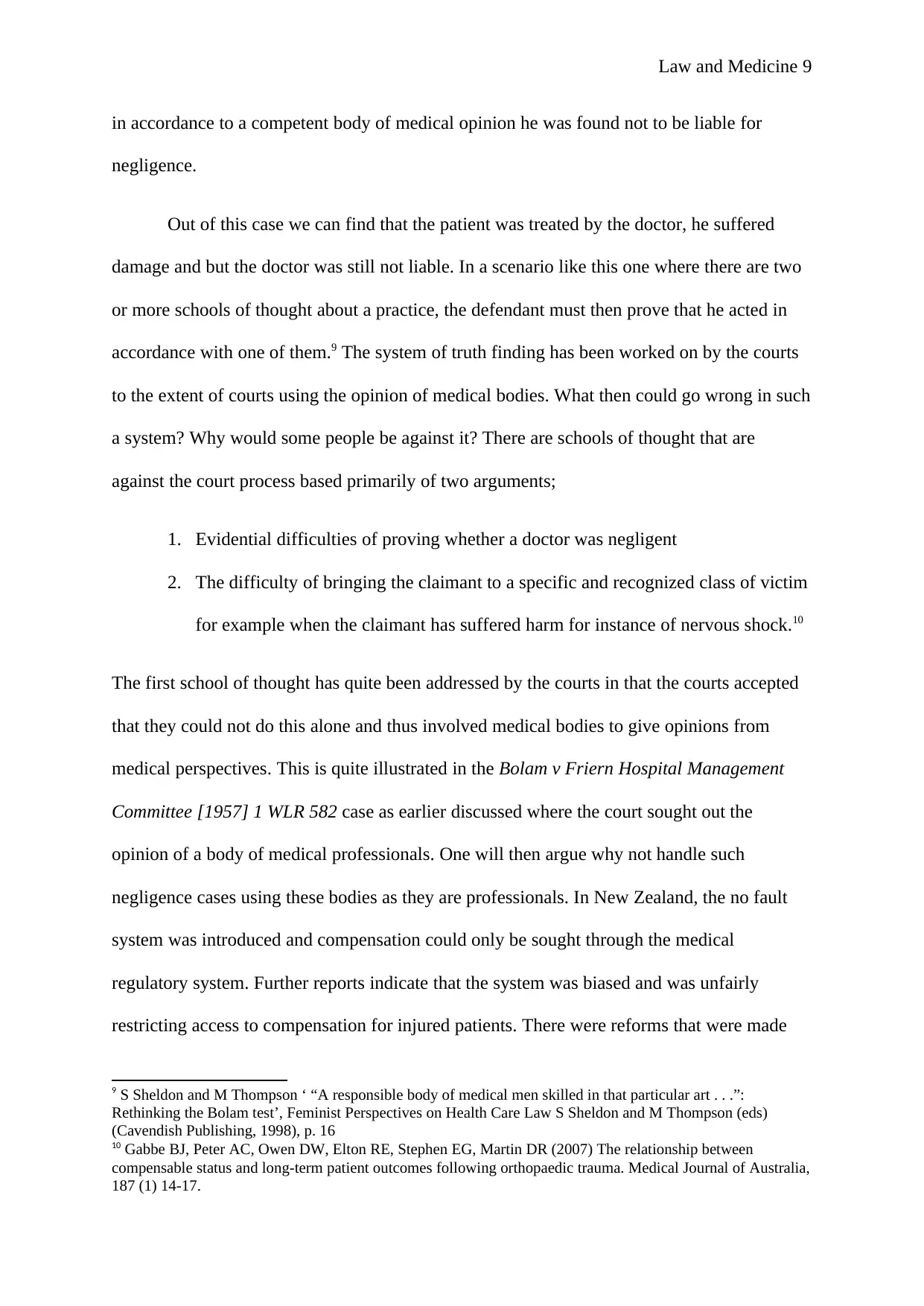
Law and Medicine 9
in accordance to a competent body of medical opinion he was found not to be liable for
negligence.
Out of this case we can find that the patient was treated by the doctor, he suffered
damage and but the doctor was still not liable. In a scenario like this one where there are two
or more schools of thought about a practice, the defendant must then prove that he acted in
accordance with one of them.9 The system of truth finding has been worked on by the courts
to the extent of courts using the opinion of medical bodies. What then could go wrong in such
a system? Why would some people be against it? There are schools of thought that are
against the court process based primarily of two arguments;
1. Evidential difficulties of proving whether a doctor was negligent
2. The difficulty of bringing the claimant to a specific and recognized class of victim
for example when the claimant has suffered harm for instance of nervous shock.10
The first school of thought has quite been addressed by the courts in that the courts accepted
that they could not do this alone and thus involved medical bodies to give opinions from
medical perspectives. This is quite illustrated in the Bolam v Friern Hospital Management
Committee [1957] 1 WLR 582 case as earlier discussed where the court sought out the
opinion of a body of medical professionals. One will then argue why not handle such
negligence cases using these bodies as they are professionals. In New Zealand, the no fault
system was introduced and compensation could only be sought through the medical
regulatory system. Further reports indicate that the system was biased and was unfairly
restricting access to compensation for injured patients. There were reforms that were made
9 S Sheldon and M Thompson ‘ “A responsible body of medical men skilled in that particular art . . .”:
Rethinking the Bolam test’, Feminist Perspectives on Health Care Law S Sheldon and M Thompson (eds)
(Cavendish Publishing, 1998), p. 16
10 Gabbe BJ, Peter AC, Owen DW, Elton RE, Stephen EG, Martin DR (2007) The relationship between
compensable status and long-term patient outcomes following orthopaedic trauma. Medical Journal of Australia,
187 (1) 14-17.
in accordance to a competent body of medical opinion he was found not to be liable for
negligence.
Out of this case we can find that the patient was treated by the doctor, he suffered
damage and but the doctor was still not liable. In a scenario like this one where there are two
or more schools of thought about a practice, the defendant must then prove that he acted in
accordance with one of them.9 The system of truth finding has been worked on by the courts
to the extent of courts using the opinion of medical bodies. What then could go wrong in such
a system? Why would some people be against it? There are schools of thought that are
against the court process based primarily of two arguments;
1. Evidential difficulties of proving whether a doctor was negligent
2. The difficulty of bringing the claimant to a specific and recognized class of victim
for example when the claimant has suffered harm for instance of nervous shock.10
The first school of thought has quite been addressed by the courts in that the courts accepted
that they could not do this alone and thus involved medical bodies to give opinions from
medical perspectives. This is quite illustrated in the Bolam v Friern Hospital Management
Committee [1957] 1 WLR 582 case as earlier discussed where the court sought out the
opinion of a body of medical professionals. One will then argue why not handle such
negligence cases using these bodies as they are professionals. In New Zealand, the no fault
system was introduced and compensation could only be sought through the medical
regulatory system. Further reports indicate that the system was biased and was unfairly
restricting access to compensation for injured patients. There were reforms that were made
9 S Sheldon and M Thompson ‘ “A responsible body of medical men skilled in that particular art . . .”:
Rethinking the Bolam test’, Feminist Perspectives on Health Care Law S Sheldon and M Thompson (eds)
(Cavendish Publishing, 1998), p. 16
10 Gabbe BJ, Peter AC, Owen DW, Elton RE, Stephen EG, Martin DR (2007) The relationship between
compensable status and long-term patient outcomes following orthopaedic trauma. Medical Journal of Australia,
187 (1) 14-17.
⊘ This is a preview!⊘
Do you want full access?
Subscribe today to unlock all pages.

Trusted by 1+ million students worldwide
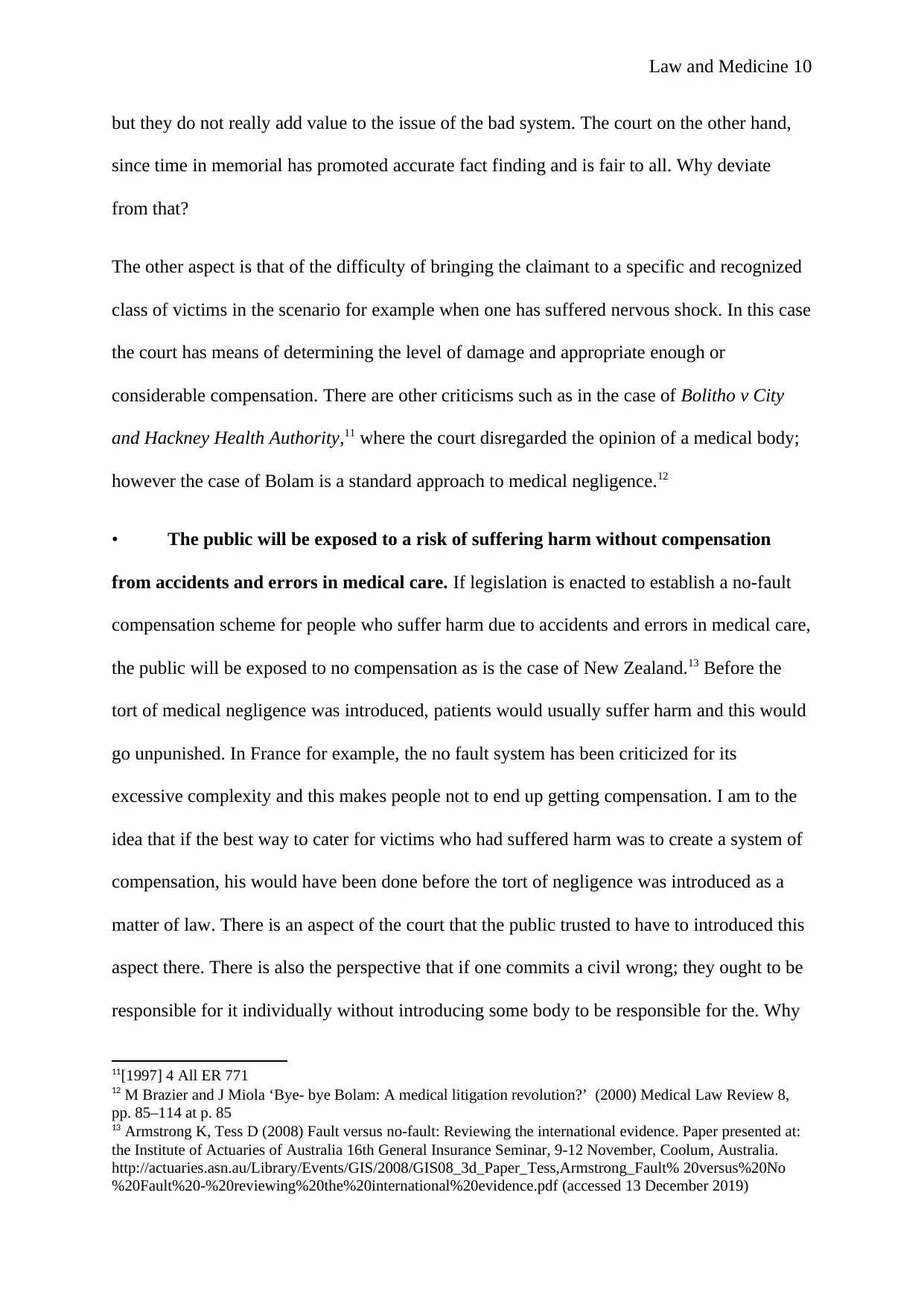
Law and Medicine 10
but they do not really add value to the issue of the bad system. The court on the other hand,
since time in memorial has promoted accurate fact finding and is fair to all. Why deviate
from that?
The other aspect is that of the difficulty of bringing the claimant to a specific and recognized
class of victims in the scenario for example when one has suffered nervous shock. In this case
the court has means of determining the level of damage and appropriate enough or
considerable compensation. There are other criticisms such as in the case of Bolitho v City
and Hackney Health Authority,11 where the court disregarded the opinion of a medical body;
however the case of Bolam is a standard approach to medical negligence.12
• The public will be exposed to a risk of suffering harm without compensation
from accidents and errors in medical care. If legislation is enacted to establish a no-fault
compensation scheme for people who suffer harm due to accidents and errors in medical care,
the public will be exposed to no compensation as is the case of New Zealand.13 Before the
tort of medical negligence was introduced, patients would usually suffer harm and this would
go unpunished. In France for example, the no fault system has been criticized for its
excessive complexity and this makes people not to end up getting compensation. I am to the
idea that if the best way to cater for victims who had suffered harm was to create a system of
compensation, his would have been done before the tort of negligence was introduced as a
matter of law. There is an aspect of the court that the public trusted to have to introduced this
aspect there. There is also the perspective that if one commits a civil wrong; they ought to be
responsible for it individually without introducing some body to be responsible for the. Why
11[1997] 4 All ER 771
12 M Brazier and J Miola ‘Bye- bye Bolam: A medical litigation revolution?’ (2000) Medical Law Review 8,
pp. 85–114 at p. 85
13 Armstrong K, Tess D (2008) Fault versus no-fault: Reviewing the international evidence. Paper presented at:
the Institute of Actuaries of Australia 16th General Insurance Seminar, 9-12 November, Coolum, Australia.
http://actuaries.asn.au/Library/Events/GIS/2008/GIS08_3d_Paper_Tess,Armstrong_Fault% 20versus%20No
%20Fault%20-%20reviewing%20the%20international%20evidence.pdf (accessed 13 December 2019)
but they do not really add value to the issue of the bad system. The court on the other hand,
since time in memorial has promoted accurate fact finding and is fair to all. Why deviate
from that?
The other aspect is that of the difficulty of bringing the claimant to a specific and recognized
class of victims in the scenario for example when one has suffered nervous shock. In this case
the court has means of determining the level of damage and appropriate enough or
considerable compensation. There are other criticisms such as in the case of Bolitho v City
and Hackney Health Authority,11 where the court disregarded the opinion of a medical body;
however the case of Bolam is a standard approach to medical negligence.12
• The public will be exposed to a risk of suffering harm without compensation
from accidents and errors in medical care. If legislation is enacted to establish a no-fault
compensation scheme for people who suffer harm due to accidents and errors in medical care,
the public will be exposed to no compensation as is the case of New Zealand.13 Before the
tort of medical negligence was introduced, patients would usually suffer harm and this would
go unpunished. In France for example, the no fault system has been criticized for its
excessive complexity and this makes people not to end up getting compensation. I am to the
idea that if the best way to cater for victims who had suffered harm was to create a system of
compensation, his would have been done before the tort of negligence was introduced as a
matter of law. There is an aspect of the court that the public trusted to have to introduced this
aspect there. There is also the perspective that if one commits a civil wrong; they ought to be
responsible for it individually without introducing some body to be responsible for the. Why
11[1997] 4 All ER 771
12 M Brazier and J Miola ‘Bye- bye Bolam: A medical litigation revolution?’ (2000) Medical Law Review 8,
pp. 85–114 at p. 85
13 Armstrong K, Tess D (2008) Fault versus no-fault: Reviewing the international evidence. Paper presented at:
the Institute of Actuaries of Australia 16th General Insurance Seminar, 9-12 November, Coolum, Australia.
http://actuaries.asn.au/Library/Events/GIS/2008/GIS08_3d_Paper_Tess,Armstrong_Fault% 20versus%20No
%20Fault%20-%20reviewing%20the%20international%20evidence.pdf (accessed 13 December 2019)
Paraphrase This Document
Need a fresh take? Get an instant paraphrase of this document with our AI Paraphraser

Law and Medicine 11
is no one asking where money from the compensation programme will be generated from? If
it is the sued doctor, why then not just use the courts as we always have. The practicability of
compensation body is too low and in a significant level exposes the public to no
compensation at all after harm has occurred.
• Other professional fields have a standard of care and medicine being a
professional field needs its own. It is not only in the medical field that a person is required
to act in accordance with the standards accepted by a competent body of opinion. This is the
required to other professions and people could be held liable for the same. A good illustration
is in the case of Luxmoore- May v Messenger May and Baverstock,14 where auctioneers were
subjected to the test of negligence in their profession. Other professions also have their
standards of conducting activities and medicine has not been secluded to be treated unfairly.
Compensation is quite not the way to go because as seen in France, the system has been seen
and criticized to be very complex and people end up not being compensated. On the other
hand in New Zealand, there are reports of increased negligence claims and also the system of
compensation is flawed and does not operate effectively.
Conclusion
Unless there are actual solid grounds that the current system of the law (tort of
negligence) has failed, then there is no reason to deter from the current system. Up to this
moment, the system has served us well. Yes, it may have some issues, challenges and
disadvantages15 as any system would but it is still the best alternative we have at the
moment.16 For instance, in the United States, out of approximated 200,000 cases of
14 [1990] 1 All ER 1067
15 Baicker K, Fisher ES, Chandra A (2007) Malpractice liability costs and the practice of medicine in the
Medicare program. Health Affairs, 26: 841-852.
16 Baicker K, Chandra A (2005) Defensive medicine and disappearing doctors? Regulation, 28: 24-31.
is no one asking where money from the compensation programme will be generated from? If
it is the sued doctor, why then not just use the courts as we always have. The practicability of
compensation body is too low and in a significant level exposes the public to no
compensation at all after harm has occurred.
• Other professional fields have a standard of care and medicine being a
professional field needs its own. It is not only in the medical field that a person is required
to act in accordance with the standards accepted by a competent body of opinion. This is the
required to other professions and people could be held liable for the same. A good illustration
is in the case of Luxmoore- May v Messenger May and Baverstock,14 where auctioneers were
subjected to the test of negligence in their profession. Other professions also have their
standards of conducting activities and medicine has not been secluded to be treated unfairly.
Compensation is quite not the way to go because as seen in France, the system has been seen
and criticized to be very complex and people end up not being compensated. On the other
hand in New Zealand, there are reports of increased negligence claims and also the system of
compensation is flawed and does not operate effectively.
Conclusion
Unless there are actual solid grounds that the current system of the law (tort of
negligence) has failed, then there is no reason to deter from the current system. Up to this
moment, the system has served us well. Yes, it may have some issues, challenges and
disadvantages15 as any system would but it is still the best alternative we have at the
moment.16 For instance, in the United States, out of approximated 200,000 cases of
14 [1990] 1 All ER 1067
15 Baicker K, Fisher ES, Chandra A (2007) Malpractice liability costs and the practice of medicine in the
Medicare program. Health Affairs, 26: 841-852.
16 Baicker K, Chandra A (2005) Defensive medicine and disappearing doctors? Regulation, 28: 24-31.
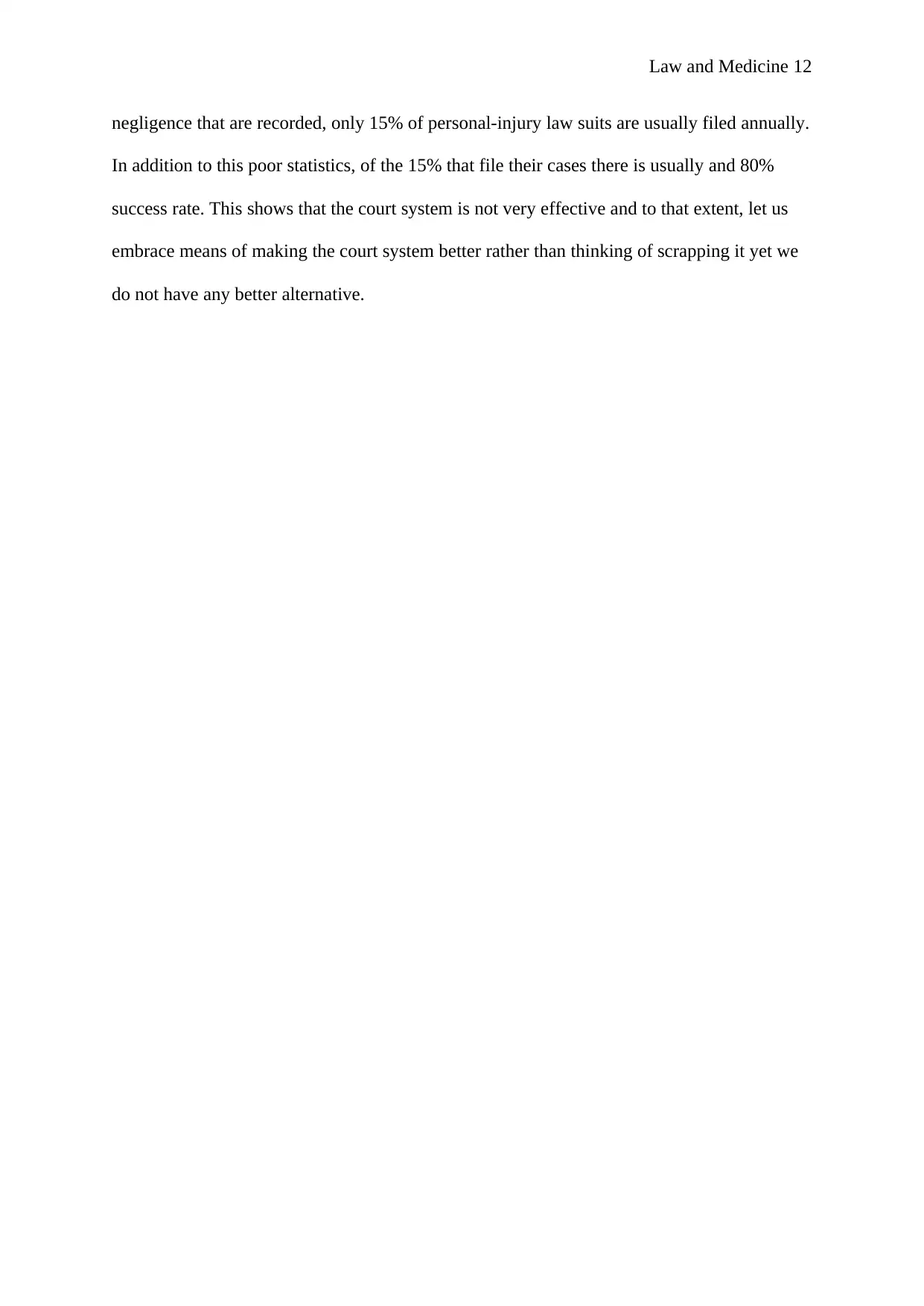
Law and Medicine 12
negligence that are recorded, only 15% of personal-injury law suits are usually filed annually.
In addition to this poor statistics, of the 15% that file their cases there is usually and 80%
success rate. This shows that the court system is not very effective and to that extent, let us
embrace means of making the court system better rather than thinking of scrapping it yet we
do not have any better alternative.
negligence that are recorded, only 15% of personal-injury law suits are usually filed annually.
In addition to this poor statistics, of the 15% that file their cases there is usually and 80%
success rate. This shows that the court system is not very effective and to that extent, let us
embrace means of making the court system better rather than thinking of scrapping it yet we
do not have any better alternative.
⊘ This is a preview!⊘
Do you want full access?
Subscribe today to unlock all pages.

Trusted by 1+ million students worldwide
1 out of 16
Your All-in-One AI-Powered Toolkit for Academic Success.
+13062052269
info@desklib.com
Available 24*7 on WhatsApp / Email
![[object Object]](/_next/static/media/star-bottom.7253800d.svg)
Unlock your academic potential
Copyright © 2020–2025 A2Z Services. All Rights Reserved. Developed and managed by ZUCOL.